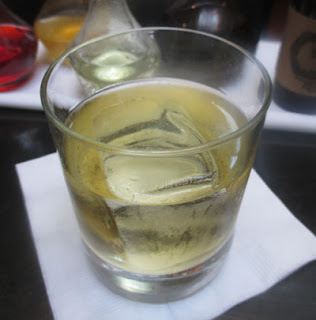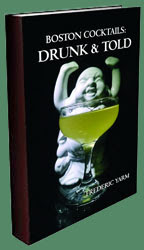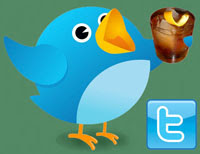
The second to last talk at Tales of the Cocktail 2016 might have been my favorite for it brought together four different voices that all swirled around the topic to complement the others and support the thesis. The panel consisted of Adam Rogers who wrote
Proof: The Science of Booze that I read 2 years ago, Andrew Toplack who is a medical doctor besides running a wine and spirits import company, Gary Regan who has served as a cocktail professor to many of us and runs the Cocktails in the Country retreat, and Nick Kennedy as moderator who left his neuroscientist studies for the bar world where he now owns Toronto's Civil Liberties Bar.
Nick began the talk by discussing how this would be all about science -- not the science about the ingredients but about our brains. The brain is not a static bundle of neurons as once believed, for we are constantly constructing new neurons and connections. In fact, our jobs change our brains as neuroplasticity makes us get better at our tasks. In bartending, this improvement comes in the cerebellum for emotional tracking and in the frontal lobe for smell and taste. In a post-mixology world, bartenders could be replaced drink-wise by robots, but to make a hospitable bar, we must hire hospitable staff. And hospitable staff have the ability to make someone feel welcome.
Andrew continued on that a robot while capable of making drinks is not a human being. If you can figure out why people really go to a bar, you can try to provide it. In the end, you go to a bar because of how it makes you feel. Knowledge gleaned from a clothing designer's manifesto is that everyone is insecure -- from the shy introvert to the confident businessman. We go to bars because we hope that we might matter to someone. This can include hoping that the bartender can recognize us, is truly happy that we have been there before, and knows what we drink. While the quality of the drink is important, without the warmth and connection of the bartender, they might not be back or back as often. A training section on human emotions should be an essential part of the restaurant industry education.
People go to a psychotherapist as they are a caring person with life experience who will listen to them. The bartender has a similar role as we offer unconditional positive regard, we listen, we witness major events in their lives, and we might be the best part of their week. Andrew continued on my citing Ray Oldenburg's
The Great Good Place that I discussed in last year's Tales talk
The Anthropology of the Modern Bar. The three spaces are first home, second work, and third is a place that people can come together for connection. This third space is a neutral ground with no obligation to be there. There is a leveling such that outside status does not mean as much, and conversation is the main activity here. The regulars set the tone and the mood as well as attract and welcome (or make unwelcome) all new comers. This third space can be a home away from home with a lot of warmth. Social architecture, a conscious design of a social environment to optimize human interactions, also plays a role. There are definitely ways to design the social space to smooth and enhance the flow of human interaction. Statistics say that 80% of all new restaurants in NYC fail, and it is believed that poorly managed social architecture plays a major role for most of the bad reviews of these restaurants are service driven. Finally, Andrew ended his section with a quote from Paul Tuennerman:

Adam was batting third with the topic of the psychoactivity of a couple of drinks. The study of drinking goes back centuries with a great example being Thomas Nashe's 1592 pamphlet that describes the
Eight Kindes of Drunkennes, and not too much has changed behavior-wise. One of the key parts of studying the brain is what happens in the perfect moment between the first and third rounds. Indeed, it is hard to give a placebo without the person knowing; however, a chilled 1:5 vodka tonic makes it rather hard to tell if there is alcohol in there. With that, you can make four groups with the axes being +/- expects booze and +/- gets booze. People who expect alcohol but do not get it still act tipsy, slur their words, and even get red in the face. This led into discussing expectancies: what you expect the night will be like is what you will be; for example, if you think tequila will make you angry and violent, you probably will be. While bartenders can build expectancies at bars, the guests bring in their own. Adam cited MacAndrew & Edgarton's
Drunken Comportment: A Social Explanation where the authors declare that alcohol has no intrinsic effects for it is all what the drinker brings with them. When cultures are analyzed, the effects of drinking are different save for one: across all cultures, alcohol will make you violent. In fact, we do not know how alcohol effects the brain because we do not know how the brain works. It is known that alcohol allows for the release of opiods that effect reward processing and control and decision making. Finally, the hangover was analyzed and electrolytes and hydration do not seem to be a major factor, but perhaps inflammation is. Likewise, the flu is similar to the hangover in effects.
Gary was batting clean up at this talk with his views on the mindful bartender. I discussed some of his treatise after attending his
Cocktails in the Country spring 2015, and other
aspects after reading his
Annual Manual for Bartenders: 2011. Gary started with a quote from Maya Angelou that has a lot of applicability to bartending, "I've learned that people will forget what you said, people will forget what you did, but people will never forget how you made them feel." Mindful in Gary's context is total awareness of all parts of the bar, and this will lead to a busier bar, more tips, happier guests, and a more pleasant work environment. One cannot be mindful all the time, so do not be hard on yourself about it. Also, as Oscar Wilde said, "Life is too important to be taken seriously," so never take anything including yourself too seriously. The best tool as a bartender is your intuition; Albert Einstein once said, "The intuitive mind is a sacred gift and the rational mind is a faithful servant. We have created a society that honors the servant and has forgotten the gift." Intuition will allow you to know when people are staring at you, when there is tension between two people, and when someone should not be served.
For mindful communication, make eye contact, ask the guest how they are doing, and then stand there until you get an answer. When the guest realized that you are waiting for their answer and you respond to it, you have created a bond and shown that you are generally interested in their welfare. Gary recommended that the one be mindful of their phrasing and the tyranny of "should." Once that word is used, a barrier can go up. Instead, opt for "you might want to think about..." which offers a choice to follow the advice or not. "I need your help" can also get a person to turn over their car keys or perhaps be used on a ring leader once pulled aside to get their rowdy group to tone it down or move it along to the next bar.
Gary declared that fear and love are key, and every other emotion is based on these two. Anger is based on being afraid; if you take away fear, you can take away the anger in a situation. One can count to ten and in that time figure out what you are afraid of, and when you get angry, it is really only effecting one person -- you. Finally, mindfulness can change your reality. For example, if you pretend to like the people you really do not, those people will change.
At the end of the talk, I went to shake hands with Gary and instead was greeted with a warm hug. I said that it was great to hear four voices all saying different but supportive things, and it was good to have a refresher on his material. He replied that he used to ask his brother who always carried around a Bible if he was done reading that thing already; similarly, rethinking our behaviors is not a one time cure-all.

















 The theme for this month's
The theme for this month's 





















 The final talk I attended at Tales of the Cocktail 2016 was given by David Wondrich (author) and Eric Seed (Haus Alpenz importer) on the Americano. I was surprised to learn that the drink was not specifically a Campari drink, but the company's perserverance paid off to make it the dominant recipe. Americanos were simply vermouth and herbal liqueur lightened by soda water with a lot of variety in the digestif identity. Moreover, I was glad to see aperitifs being spoken of, as well as there being a celebration of low ABV drinks in general. It was explained that Italians love to drink before dinner, but they like to keep the proof rather low at that point of the evening.
The final talk I attended at Tales of the Cocktail 2016 was given by David Wondrich (author) and Eric Seed (Haus Alpenz importer) on the Americano. I was surprised to learn that the drink was not specifically a Campari drink, but the company's perserverance paid off to make it the dominant recipe. Americanos were simply vermouth and herbal liqueur lightened by soda water with a lot of variety in the digestif identity. Moreover, I was glad to see aperitifs being spoken of, as well as there being a celebration of low ABV drinks in general. It was explained that Italians love to drink before dinner, but they like to keep the proof rather low at that point of the evening.




 The 2017 collection of 855 drink recipes, bartender tributes, and essays on hospitality from CocktailVirgin's Frederic Yarm. Available at
The 2017 collection of 855 drink recipes, bartender tributes, and essays on hospitality from CocktailVirgin's Frederic Yarm. Available at  The 2012 collection of 505 drink recipes, techniques, and Boston bar recommendations from Frederic Yarm. Available at
The 2012 collection of 505 drink recipes, techniques, and Boston bar recommendations from Frederic Yarm. Available at 



